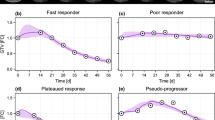Abstract
A general treatment for mean residence time, clearance, and volume parameters in linear mammillary models which includes the possibility of first-order elimination from compartments other than the central compartment is presented. The interrelationship between noncompartmentally derived parameters and compartmentally derived pharmacokinetic microconstants is described. The concept of exit site dependent and exit site independent parameters is introduced in the development of these treatments. Explications of mean residence time in terms of elimination rate, amount eliminated, and amount in the body are presented together with demonstrations of their utility.
Similar content being viewed by others
References
K. Yamaoka, T. Nakagawa, and T. Uno. Statistical moments in pharmacokinetics.J. Pharmacokin. Biopharm. 6:547–558 (1978).
D. J. Cutler. Theory of the mean absorption time, an adjunct to conventional bioavailability studies.J. Pharm. Pharmacol. 30:476–478 (1978).
H. M. von Hattingberg and D. Brockmeier. In N. Rietbrock and B. Schnieders (eds.),Bioverfügbarkeit von Arzneimitteln, Gustav Fischer, Stuttgart, 1979, pp. 191–209.
H. M. von Hattingberg and D. Brockmeier. In G. Bozler and J. M. van Rossum (eds.),Pharmacokinetics during Drug Development: Data Analysis and Evaluation Techniques, Gustav Fischer, Stuttgart, 1982, pp. 315–323.
S. Riegelman and P. Collier. The application of statistical moment theory to the evaluation ofin vivo dissolution time and absorption time.J. Pharmacokin. Biopharm. 8:509–535 (1980).
L. Z. Benet and R. L. Galeazzi. Noncompartmental determination of the steady-state volume of distribution.J. Pharm. Sci. 68:1071–1074 (1979).
M. Weiss. Moments of physiological transit time distributions and the time course of drug disposition in the body.J. Math. Biol. 15:305–318 (1982).
D. O. Chanter. The determination of mean residence time using statistical moments: Is it correct?J. Pharmacokin. Biopharm. 13:93–100 (1985).
E. M. Landaw and D. Katz. Comments on mean residence time determination.J. Pharmacokin. Biopharm. 13:543–547 (1985).
W. R. Gillespie and P. Veng-Pedersen. The determination of mean residence time using statistical moments: It is correct.J. Pharmacokin. Biopharm. 13:549–554 (1985).
L. Z. Benet. Mean residence time in the body versus mean residence time in the central compartment.J. Pharmacokin. Biopharm. 13:555–558 (1985).
D. J. Cutler. Definition of mean residence times in pharmacokinetics.Biopharm. Drug Dispos. 8:87–97 (1987).
N. A. Lassen and W. Perl.Tracer Kinetic Methods in Medical Physiology, Raven Press, New York, 1979.
P. Veng-Pedersen and W. Gillespie. Mean residence time in peripheral tissue: A linear disposition parameter useful for evaluating a drug's tissue distribution.J. Pharmacokin. Biopharm. 12:535–543 (1984).
P. Veng-Pedersen and W. Gillespie. The mean residence time of drugs in the systemic circulation.J. Pharm. Sci. 74:791–792 (1985).
P. Veng-Pedersen and W. R. Gillespie. Single pass mean residence time in peripheral tissues: A distribution parameter intrinsic to the tissue affinity of a drug.J. Pharm. Sci. 75:1119–1126 (1986).
P. P. LeBlanc and M. LeBel. Drug distribution in the body: I. Estimation of the rate and extent of distribution using statistical moments.J. Pharm. Belg. 41:69–74 (1986).
P. P. LeBlanc and M. LeBel. Drug distribution in the body: II. Estimation of drug concentration in small anatomic compartments.J. Pharm. Belg. 41:75–82 (1986).
P. J. McNamara, J. C. Fleishaker, and T. L. Hayden. Mean residence time in peripheral tissues.J. Pharmacokin. Biopharm. 15:439–450 (1987).
L. Z. Benet. General treatment of linear mammillary models with elimination from any. compartment as used in pharmacokinetics.J. Pharm. Sci. 61:536–540 (1972).
K. B. Bischoff and R. L. Dedrick. Thiopental pharmacokinetics.J. Pharm. Sci. 57:1346–1351 (1968).
M. Rowland, L. Z. Benet, and G. G. Graham. Clearance concepts in pharmacokinetics.J. Pharmacokin. Biopharm. 1:123–135 (1973).
M. Weiss. Residence time and accumulation of drugs in the body.Int. J. Clin. Pharmacol. Ther. Toxicol. 19:82–85 (1981).
J. J. DiStefano III. Noncompartmental vs. compartmental analysis: Some bases for choice.Am. J. Physiol. 243:R1-R6 (1982).
E. A. Nüesch. Noncompartmental approach in pharmacokinetics using moments.Drug Metab. Rev. 15:103–131 (1984).
J. J. DiStefano III and E. M. Landaw. Multiexponential, multicompartmental, and non-compartmental modeling. I. Methodological limitation and physiological interpretations.Am. J. Physiol. 246 (Regulatory Integrative Comp. Physiol.15): R651-R664 (1984).
C. Cobelli and G. Toffolo. Compartmental and noncompartmental models as candidate classes for kinetic modeling, theory and computational aspects. In J. Eisenfeld and C. Delisi (eds.),Mathematics and Computers in Biomedical Applications, Elsevier, Amsterdam, 1985, pp. 219–236.
S. L. Beal. Some clarifications regarding moments of residence times with pharmacokinetic models.J. Pharmacokin. Biopharm. 15:75–92 (1987).
L. Z. Benet and R. A. Ronfeld. Volume terms in pharmacokinetics.J. Pharm. Sci. 58:639–641 (1969).
P. S. Collier. Some considerations on the estimation of steady state apparent volume of distribution and the relationships between volume terms.J. Pharmacokin. Biopharm. 11:93–105 (1983).
E. Nakashima and L. Z. Benet. Simulation studies of mean residence time for drugs with peripheral elimination: Application to nitroglycerin.J. Pharm. Sci. 76:S106 (1987) (Abstract).
W. J. Jusko and M. Gibaldi, Effects of change in elimination on various parameters of the two-compartment open model.J. Pharm. Sci. 61:1270–1273 (1972).
L. Z. Benet, Pharmacokinetic parameters: Which are necessary to define a drug substance?Eur. J. Resp. Dis. 65(Suppl. 134):45–61 (1984).
M. Gibaldi, R. Nagashima, and G. Levy, Relationship between drug concentration in plasma or serum and amount of drug in the body.J. Pharm. Sci. 58:193–197 (1969).
Author information
Authors and Affiliations
Additional information
Supported in part by NIH grants GM 26691 and HL 32243.
Rights and permissions
About this article
Cite this article
Nakashima, E., Benet, L.Z. General treatment of mean residence time, clearance, and volume parameters in linear mammillary models with elimination from any compartment. Journal of Pharmacokinetics and Biopharmaceutics 16, 475–492 (1988). https://doi.org/10.1007/BF01062381
Received:
Revised:
Published:
Issue Date:
DOI: https://doi.org/10.1007/BF01062381




